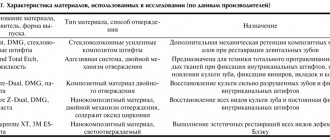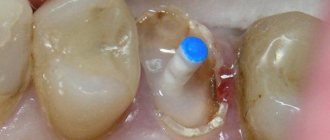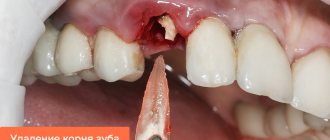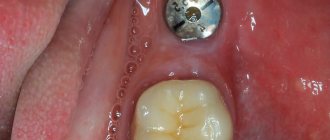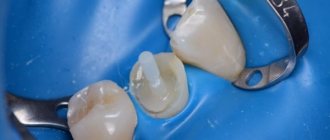Dental pin: what is it, its advantages and disadvantages
What is a dental post? This is a specialized dental structure that looks like a rod. It is installed into the tooth root as a support for a filling or crown. Installation of a pin is only possible if the tooth has a healthy root. As a rule, this design is used if the tooth is badly damaged and thin walls remain.
Advantages:
- reducing the load on the tooth root;
- the ability to restore the crown in just one visit to the dentist;
- ease of installation;
- high level of aesthetics of the future artificial tooth;
- relatively low cost.
Flaws:
- instability under heavy chewing loads;
- there is a risk of damage to the root walls;
- allergic reactions and the development of secondary caries are possible;
- metal rods can only be removed together with the tooth.
To successfully install the pin, the following conditions will need to be met:
- the length of the rod must be at least 2/3 of the length of the dental canal;
- the size of the rim of healthy tooth tissue is at least 2 mm;
- root canal treatment was carried out with high quality;
- the root canal was given a cylindrical or conical shape.
Why do you need pins at all?
Pins are used in cases where a tooth destroyed by caries or injury cannot be restored in the usual way, that is, by filling a cavity cleared of caries with filling material. This usually happens if treatment is too late, and the disease is so advanced that only thin walls remain of the tooth. In such a situation, the pin serves as a support on which the crown or fixed bridge .
In addition, pins are also used to solve other problems. Thus, the pin often acts as an auxiliary tool when reinforcing a tooth in which the pulp has been removed. Often, pins are also not an independent element, but part of a structure that is made for splinting the dentition in case of periodontal diseases. In this case, the doctor’s task is to “hold” the teeth in the gums.
How long does it take to install a pin and how painful is this process?
The duration of the procedure directly depends on the initial condition of the oral cavity. If there are no problems, the pin is placed in one visit to the dentist. If periodontal diseases and other pathologies are present, a pin will be installed in the tooth root only after they have been eliminated.
Since the doctor touches soft tissue during the implantation of the supporting element, the procedure is often accompanied by painful sensations. The occurrence of pain after nerve removal is a natural process. But if a long-depulped tooth hurts, it is possible that the rod has entered too deeply into the canal. X-rays will help identify the cause of the pain.
Types of pins
- Made from fiberglass, the post quickly became popular among dentists due to its hypoallergenic properties. The material, which does not come into contact with the tissues of the oral cavity, does not rust, does not lose strength over time, and can also be removed if necessary with a minimum of effort.
- The carbon fiber pin is also considered durable and modern. In terms of its characteristics, especially elasticity, it is in many ways similar to natural dentin, that is, tooth tissue, which significantly reduces the likelihood of an unpleasant complication - a root fracture.
- Pins with the complex name “parapulpal” are made from a metal alloy with stainless properties and then coated with polymer. They are not used in the pulp, but serve as additional supporting structures.
- Pins are also made of titanium, ceramic, and metal. In each specific case, the doctor makes a decision on the use of one or another type of pin individually, based on the condition of the patient’s dentition.
- Promotion SGS Implant + crown
Promotion for turnkey dental implantationSGS implant + healing abutment + abutment + crown + work
old price
57 300 ₽
turnkey price, with 100% payment
24 900 ₽
Book an implant
The offer is limited, book the implants on offer in advance. Sign up for a free consultation. Your reservation is valid only after making an advance payment under the Agreement, no later than 10 days from the date of the initial consultation.
- Promotion
Osstem implant + zirconium crown
Promotion for turnkey dental implantation
Osstem implant + healing abutment + abutment + zirconium crown + work
old price
68 400 ₽
turnkey price, with 100% payment
29 900 ₽
Book an implant
The offer is limited, book the implants on offer in advance. Sign up for a free consultation. Your reservation is valid only after making an advance payment under the Agreement, no later than 10 days from the date of the initial consultation.
- Promotion
Astra Tech implant + zirconium crown
Promotion for turnkey dental implantation
Astra Tech implant + gum former + abutment + zirconium crown + work
old price
88 400 ₽
turnkey price, with 100% payment
59 900 ₽
Book an implant
The offer is limited, book the implants on offer in advance. Sign up for a free consultation. Your reservation is valid only after making an advance payment under the Agreement, no later than 10 days from the date of the initial consultation.
- Promotion
Nobel implant + zirconium crown
Promotion for turnkey dental implantation
Nobel implant + healing abutment + abutment + zirconium crown + work
old price
88 400 ₽
turnkey price, with 100% payment
59 900 ₽
Book an implant
The offer is limited, book the implants on offer in advance. Sign up for a free consultation. Your reservation is valid only after making an advance payment under the Agreement, no later than 10 days from the date of the initial consultation.
- Promotion
Straumann implant + zirconium crown
Promotion for turnkey dental implantation
Implant Straumann Roxolid SLActive (
No. 1 in the World! ) + gum former + abutment + zirconium crown + work
old price98 400 ₽
price turnkey price, with 100% payment
59 900 ₽
Book an implant
The offer is limited, book the implants on offer in advance. Sign up for a free consultation. Your reservation is valid only after making an advance payment under the Agreement, no later than 10 days from the date of the initial consultation.
Indications and contraindications for installing pins
Indications:
- damage to the tooth crown by more than 50%;
- the need to create support for prostheses;
- tooth loss;
- weakening of the tooth due to dental diseases.
Contraindications:
- untreated caries;
- the presence of inflammatory processes in the area of the tooth root;
- root destruction;
- blood diseases;
- insufficient thickness of the root canal;
- the presence of caries and periodontal inflammation;
- granulomas, cysts;
- exacerbation of systemic diseases;
- pregnancy;
- allergy.
It is important to know. The choice of the most suitable type of pin is always up to the doctor. It is unacceptable to focus only on the cost of the dental structure.
Titanium pin in tooth
The pins located in the tooth canals can be made of titanium, but they should not be confused with implants. Dental pins belong to endodontics and partly to orthopedics, while implantation is a separate area. When a titanium pin is placed in an extracted tooth, the product is called an “implant.” This is an artificial root that is implanted in place of a lost tooth. Theoretically, a dental implant can be called a titanium post (which many people often do), but compared to classic posts, it performs a completely different function. The advantages of implantation today are undeniable: if a natural tooth is lost, it is the implant that can best restore its functionality and aesthetics.
Pin Installation Procedure
How to install a pin in a tooth? The procedure occurs in several stages:
- Removal of all dental tissues affected by caries.
- Preparing the bed for the pin using a special reamer and calibration cutter.
- Root canal preparation.
- Fitting the rod to the tooth.
- Installation of the pin; dual-curing adhesive is used as a fixing element.
- Restoration work using a crown or prepared filling material.
The Saint-Dent Clinic in Moscow offers a wide range of dental services for adults and children. The current cost of services can be found here, the contact page is located here.
How does the installation take place?
When preparing for the procedure, many patients wonder how exactly the intervention will take place. The complex of restorative actions is divided into two conventional stages - directly working with the pin and the process of restoring the tooth through prosthetics.
Important ! How the pin will be installed depends primarily on its type and material.
However, the procedure is usually unchanged. It must always be observed, no matter what teeth the pins are installed on: incisors, canines, molars or premolars.
How the pin is installed depends on many things
Accordingly, actions are performed in this order.
- When men experience itching in the urethra without discharge
First of all, the patient is examined by a dentist. If concomitant conditions are discovered that may adversely affect the result, they must be pre-treated. Thus, you first need to cure caries and other pathologies of the oral cavity and teeth. In order to avoid complications caused by bacterial damage, professional sanitation of the oral cavity is performed.
An X-ray of the decayed tooth is also taken. Based on the information from the image, the dentist determines the characteristics of the tooth: length, angle of inclination and root diameter.
Next, the doctor determines which pin will be installed and how. On the appointed day before installing the rod, it is better not to eat food.
The intervention is carried out after the administration of local anesthesia: it is injected into the gum next to the damaged tooth. As soon as it begins to act, the procedure itself is carried out.
The intervention is performed under local anesthesia
The dental canals are thoroughly cleaned. To do this, drills are used, usually small in size, so as not to accidentally damage the canal and cause the formation of cracks and other damage. If necessary, expand the channel.
Interesting ! A filling is usually placed at the top of the root.
If a passive pin is installed, a cementing mixture is placed into the canal. A pin is placed in it, and it is thoroughly dried using a special dental lamp.
Next, the dentist conducts a control check and schedules the next appointment for further prosthetics.
The dentist himself sets the time for the next appointment
Possible complications
- severe pain, swelling;
- root fracture;
- restoration chips;
- the occurrence of a local allergic reaction to the material from which the rod is made;
- development of the inflammatory process (stomatitis, periodontitis);
- cyst development;
- fistula formation;
- mechanical damage to the walls of the tooth, which can lead to perforation of the root canals;
- splinters from dental instruments getting into the root canal.
It is important to know. The most dangerous complication is rejection of the installed supporting element by the body. In this case, it must be completely removed from the oral cavity.
Is it worth putting a pin in a tooth?
Like all dental treatment methods, pins have their drawbacks. This list is small, but these nuances must be kept in mind before agreeing to treatment.
- Allergic reactions to metal alloys are possible.
- Even with ideal treatment, a tooth with a pin will be more vulnerable than a healthy tooth. Its service life is shortened and the tooth becomes more fragile.
- The risk of root fracture increases (especially when using classic anchor pins).
On the other hand, this technique allows you to save a tooth in almost hopeless conditions.
What to do if a tooth with a pin hurts
In the first hours, rinsing the mouth with a soda solution (1 teaspoon of soda per glass of water) will help relieve toothache. A decoction of chamomile and sage has a similar effect. You can also take painkillers and apply ice to your cheek in the area where the pin was placed.
It is important to know. The occurrence of slight swelling and pain in the first days after installation of the pin is normal. But if these symptoms persist for a long time and the patient experiences an elevated body temperature, you should consult a dentist.
Pain on pressure
Sometimes, with external mechanical influence (chewing, pressure), a feeling of pain may occur. This happens quite often, since the treatment process is quite complex, an artificial crown is installed. After some time, the pain goes away.
Another reason that causes pain when pressure is placed on a tooth is when the filling is placed too high. As a result, the jaw stops closing normally. Most often, pain of this nature occurs when chewing food. For prevention, it is recommended to remain under observation in the hospital for some time to understand whether there are any new unpleasant sensations after the intervention.
Sometimes after installing the pin, if you put pressure on the tooth, you can feel pain
The most common questions about pins and answers to them
Is it always possible to get by with a pin?
Unfortunately no. In case of significant tooth decay, when there is a risk of further destruction of the coronal part, dental prosthetics are recommended.
How to care for your teeth after having a pin installed?
For two weeks, it is not advisable to eat too hard food and use toothpicks. When brushing your teeth, you need to be as careful as possible so as not to injure your gums.
Is there an alternative to a dental post?
Yes, you can install a stump tab instead. This is a microprosthesis, the lower part of which is fixed into the root canals, and the upper part serves as a supporting element for an artificial crown.
Dental pins - what are they?
Today, doctors have a wide selection of dental pins, varying in shape, material and area of application.
Dental pin materials
- Metal.
The most popular options: titanium, brass, palladium and precious alloys. - Metal-free.
They are made from gutta-percha, ceramics, fiberglass and carbon fiber.
Forms
- screw
- cylindrical
- conical
- combined
Recovery methods
- pins for tooth crown
- tooth filling on a pin
Mounting methods
- Active.
Threaded pins are screwed into the root canal, thereby achieving a tighter fixation. However, there is a risk of perforation of the canal walls. - Passive.
A more gentle (but less reliable) method of fastening. The pin is placed inside the root canal and fixed using a special compound.
Let's sum it up
Pain after insertion of a pin occurs for various reasons, but moderate pain is normal. The maximum time through which they must pass is up to five days. If the pain lingers for a longer period of time, it is necessary to consult a doctor who will find out what caused the pain.
However, if erroneous and unprofessional actions of the dentist were noticed, which include installing the rod too deeply, non-compliance with the rules for filling the root canals, damage to them with dental instruments, an incorrectly fixed pin and pieces of dental instruments accidentally left in the canal, then the pain is usually very intense and you need to get rid of it only after consulting a doctor.
Does pain occur after the anesthesia wears off?
When patients receive a negative answer to the question of whether it is painful to insert an implant, they usually ask the following. It goes like this: “How will I feel after the anesthetic wears off?” Since implantation is a surgical intervention that is associated with tissue trauma, the body reacts to it. Normally after surgery the following occurs:
- pain of varying intensity;
- swelling of the gums and cheeks on the corresponding side of the face and jaw;
- itching, feeling of tissue compression in the area of the operation.
Dentistry also copes with such phenomena. To do this, the doctor prescribes the patient a course of painkillers, anti-inflammatory, and antibacterial drugs. If there are no complications, the prescribed medications are sufficient to eliminate severe pain. To avoid unwanted reactions of the body, you should not touch the wound with your tongue, take a hot bath, drink alcohol, or violate other recommendations of your doctor.
Why install the pin?
The pin is installed in the tooth cavity for the purpose of:
- improving the fixation of the filling (in such cases, preference is given to fiberglass or ceramic products, since they do not shine through the composite restoration, thereby not disturbing aesthetic indicators);
- formation of a tooth stump from a filling material, followed by the manufacture of a crown for this tooth (in this clinical situation, installation of metal products is possible).
Pins are recommended for use in cases of significant destruction of the tooth crown due to caries, trauma, or increased abrasion of hard tooth tissues. They can also be used by dentists for restorations of the frontal group of teeth in case of their significant inclination.
After installing a dental post
As we have already noted, after a rod has been installed or a crown has been built up, pain is normal for some time. Usually this condition goes away after three days.
However, if you notice that the pain lasts longer or does not subside, but only intensifies, you should immediately visit a dentist. This may indicate damage to the roots of the teeth or the pin being installed too deeply when it comes into direct contact with the bone tissue. The cause can only be determined using an x-ray.
If the pain does not go away for more than three days, you should consult a doctor.
Important! Some patients may be allergic to the material from which the pin is made - then we are talking about symptoms such as redness or swelling. This condition should not be neglected under any circumstances; complications such as serious inflammation - stomatitis or periodontitis - may occur.
After the pin is installed, the patient is recommended to follow a certain regimen to help him recover faster after the intervention. These recommendations should be followed for approximately two weeks.
- Give preference to soft foods to avoid stress on your teeth.
- The toothbrush should be replaced with one with the softest bristles.
- The first time after installing the pin, you should not use electric toothbrushes, toothpicks or dental floss in the area of the tooth where the rod is installed.
- Smoking should be avoided for at least one day after the pin is installed.
- Regularly use a mouth rinse solution prescribed by a specialist.
- Physical activity is minimized or eliminated completely.
- You must strictly adhere to the treatment prescribed by your dentist.
It is important to follow your dentist's recommendations
To prevent and strengthen the immune system, immunostimulants, for example, Imudon, are often prescribed before and after intervention. This drug has proven itself as a means of strengthening local immunity and protecting against infections and inflammation after the procedure.
"Imudon" is indicated for use by children over three years of age and adults. It has a convenient form of administration - these are lozenges with mint flavor.
"Imudon"
In what cases is extension indicated?
The situation when a patient comes to the doctor and asks to have his tooth augmented, and the doctor just throws up his hands and recommends taking up prosthetics, is not uncommon. Patients, of course, are not professionals to independently determine what solutions exist for this or that dental problem. In reality, attaching a tooth to a pin is not a panacea, and it is indicated in a limited number of cases.
When is tooth augmentation recommended:
- chips and various cracks of teeth;
- various types of enamel damage;
- worn enamel;
- trauma with subsequent violation of the integrity of the bone tissue itself;
- greatly altered enamel color that cannot be changed by bleaching or cleaning;
- loss of a significant part of the tooth due to caries.
If the tooth is significantly damaged, it can be built up using a pin.
3 parapulp pins are installed in the root of the tooth
Of course, there are cases when restoring a tooth by building it onto a pin has contraindications. If the patient has an allergic reaction to one or another filling material, extensions are not performed. It happens that it is impossible to protect a certain area of the oral cavity from moisture, then it is also impossible to do artistic restoration, because the composite simply cannot dry out and, naturally, will not be fixed.
A direct contraindication is bruxism. This is what is called night grinding of teeth during sleep. Very often, it is precisely because of bruxism that cracks appear on tooth enamel, and if these cracks are removed by extension, then teeth grinding will lead to the destruction of an already restored tooth. But bruxism can be cured, the main thing is to consult a doctor in time.
Bruxism is a contraindication to attaching teeth to pins. In the photo there is a mouth guard against tooth abrasion
Pins should not be placed in children's teeth. It is not advisable to restore a tooth in this way if it (or neighboring teeth) has untreated caries. Of course, the general condition of the body is also taken into account: if the patient, for example, has a cold, his blood pressure has risen, his temperature has risen, the visit to the dentist should be postponed.
Children do not have teeth built up on pins
How is a crown installed on a tooth?
If you decide to put a crown on a tooth, then it will be useful for you to know what stages of this process you will have to deal with. In the process of placing a crown on a tooth in dental clinics, the following stages can be distinguished...
Initial consultation with an orthopedist (prosthetist) −
During the initial consultation, the doctor, assessing the condition of the teeth externally and using x-rays, must offer possible prosthetic options, and the patient, accordingly, must approve one of the options. Based on this, a treatment plan is drawn up, which may take into account -
removal of non-viable teeth,- preparing teeth for crowns (filling, depulping),
- choice of the type of crowns, for bridges - the number of supporting teeth, etc.
- The cost of making crowns and treatment in general is calculated, the deadline for prosthetics is determined, after which the patient must sign a treatment plan and a contract for the provision of services.
Important: at this stage the patient must choose one of the types of artificial crowns offered to him. Choosing the type of crown is not easy for the average patient, and there are a lot of pitfalls that the dentist will never tell you about. Articles to help you choose -
→ Pros and cons of metal-ceramic crowns → How to choose crowns for front teeth
Preparing teeth for prosthetics −
In some cases, crowns can be placed on living teeth. This is preferable because dead teeth are more fragile, and therefore, if the teeth are left alive, this has a positive effect on the service life of the crowns. In what cases can teeth be left alive? As a rule, we are talking about large chewing teeth. This is due to the fact that large teeth have a greater distance from the surface of the enamel to the pulp of the tooth (than single-rooted teeth) and, therefore, the risk of thermal burn of the pulp when grinding the tooth for a crown will be much lower.
Moreover, under crowns made of metal-free ceramics, even the majority of single-rooted teeth can be left alive. This is due to the fact that under ceramics the tooth is ground down by 1.0 from the side surfaces, and under metal-ceramics – on the same surfaces by 2.0 mm. Therefore, metal-free ceramics also allows you to increase the service life of the tooth itself under the crown.
When using metal-ceramic prosthetics for single-rooted teeth, the nerve is almost always removed. If this is not done, then turning such a tooth can lead to a thermal burn of the dental pulp, i.e. neurovascular bundle. In this case, after some time, its inflammation will develop, and the crown will then have to be removed and the tooth re-treated. If the tooth under the crown is destroyed by a carious process (there is pulpitis or periodontitis), then planned depulpation of the tooth and treatment of inflammation at the apex of the root are required.
When depulping a tooth, it is carried out -
- removal of a nerve from a tooth,
- instrumental treatment and expansion of root canals (Fig. 2),
- the canals are filled with gutta-percha (Fig. 3),
- after which a filling is placed on the crown part of the tooth (Fig. 4).
Important: if the crown part of the tooth is destroyed by 1/2 or more, the tooth must be strengthened with a pin fixed in the root canal (otherwise the crown can easily fall out along with the filling). There are 2 main methods for restoring severely damaged teeth.
What is the best way to restore a badly damaged tooth? –
The first option (Fig. 5) – patients also call it a crown with a pin or a crown on a pin. This is when a pin is screwed into an already filled root canal, and then, based on it, the crown part of the tooth is restored using filling material. Only after such restoration is the tooth ground down for a crown.
- The second option (Fig. 6-8) – the crown part of the tooth is restored using a stump inlay.
Such an inlay is cast from metal in a dental laboratory and consists of a root part (which is fixed in the canal) and a crown part, which has the shape of a tooth that has already been ground for a crown. This method provides greater reliability, strength and longer service life of the crown. Making a core inlay for a crown –
Preparation of teeth for crowns −
In common parlance - grinding teeth. The preparation process is carried out by an orthopedic surgeon, who (using a drill and a set of diamond burs) gives the tooth a certain shape. Preparation is a painful process if living teeth are ground down. In this case, local anesthesia is required. When dead teeth are ground down, anesthesia is given only if the doctor needs to strongly press the gum away from the tooth during preparation.
The tooth tissue is ground down by the doctor to the thickness of the future crown (Fig. 9-11). Crowns made of metal-free ceramics (for example, zirconium dioxide or E.max glass ceramics) require less grinding of the tooth tissue - approximately 1.0 to 1.5 mm on different tooth surfaces. But under metal-ceramics, the teeth are ground down on all sides by 1.5-2.5 mm - as a result of which almost nothing remains of the tooth. As a result of preparation, the tooth crown takes on the appearance of a “stump”.
Tooth preparation for metal ceramics –
Important: high-quality tooth preparation for a crown is a very complex and time-consuming process. The most difficult thing here is to create a ledge in the gingival part of the tooth crown. The reliability and service life of your crown largely depends on the correct formation of the ledge. It must be admitted that most doctors make a lot of mistakes at this stage. How the ledge is formed is clearly shown in the video below.
Grinding front teeth for crowns: video
Taking impressions, making plaster models of teeth –
Impressions are taken from the ground teeth using special impression compounds (Fig. 12). Subsequently, based on these casts, plaster copies of your teeth are created in a dental laboratory (Fig. 13). Such plaster models depict the patient’s teeth with very high accuracy, including those ground for crowns, and it is from such models that they are manufactured.
A very important question here is what kind of impression material you will use to take impressions. Good impression compounds are “A-silicone” or, better yet, “polyester compound”. But usually, in order to save money, alginate masses or C-silicone can be used, which will affect the quality/accuracy of crowns for the worse. As a result, crowns may not fit the ground teeth, may not fit well around the neck of the tooth, and the latter will inevitably lead to rotting of the tooth under the crown.
Taking an impression of your teeth is usually a tolerable procedure that is not accompanied by pain. However, sometimes the doctor needs to insert a retraction thread deep into the gingival sulcus in order to move the gum away from the ground tooth and thereby obtain a better impression of the teeth at the gingival margin. Gum retraction is quite painful and is best performed under anesthesia. Gum retraction also has a disadvantage - very often gum avulsion can lead to the appearance of a periodontal pocket.
But there is also a group of patients for whom taking impressions is a very big problem. For example, if you have an increased gag reflex. Of course, before the actual impression is taken, you may be sprayed on the root of your tongue with Lidocaine spray (an anesthetic), but this still does not help much. In this group of patients, it is advisable to additionally use sedatives before the procedure itself.
How dental impressions are taken in dentistry: video
Making crowns in a dental laboratory –
So the casts were taken, plaster models were made. The dental technician begins to make your future crowns based on these models. Because While the manufacture of metal-ceramics and ceramics may take several weeks, while permanent crowns are being made, temporary crowns are usually made of plastic. They will not only restore aesthetics, but also protect sharpened teeth from destruction by the aggressive environment of the oral cavity.
The most important thing at this stage is that we recommend getting dentures only in those clinics that have their own dental laboratory (located directly in the clinic itself). This is necessary so that the orthopedic dentist has direct contact with the dental technician at the stages of making crowns, and the dental technician can always come to the office when trying on crowns.
The latter is very important if you want to get good aesthetics of the crowns, well-formed contact points with neighboring teeth, etc. Of course, none of this will help if your prosthetist's hands are growing out of a bad place, but at least it will improve your chances of receiving quality service.
Trying on crowns –
Before the dental technician finishes his work, it will be necessary to try on the unfinished work.
For the first time, the frame of the crowns is usually tried on, which can be either metal or made of metal-free ceramics. The second time they try on an almost finished crown, on the surface of the frame of which (after the first fitting) layers of ceramic mass, as well as dyes, were applied. It is at this stage that you can still say that you don’t like something (color, shape), and it can be corrected. Those. It is at this stage that the color is finally agreed upon, and if you have agreed on it and, moreover, signed the medical record that everything suits you, then it will be too late to make a claim. Therefore, our advice: if you are not satisfied with anything and you are ashamed to point it out to the doctor, be sure to say so, and do not sign anything until you are really satisfied with the results of the work.
After the final fitting, your crown is sent back to the laboratory where it goes through the glazing process to achieve its final look and shine. At your next visit, you will have ready-made crowns fixed with permanent or temporary “cement.”
Video of fitting of E.max ceramic crowns –
Temporary / permanent fixation of crowns –
In principle, there is no need for temporary fixation as such. It is necessary, and you should insist on it only if for some reason you are not sure of the quality of the work or something confuses you (the color/shape of the crowns, their visibility against the background of neighboring teeth). If the crowns are placed on permanent cement, they can only be removed by sawing.
If you insist on temporary fixation, and the dentist refuses you, this is also a signal to think about the quality of the work. Such cases and conflicts on this matter between the doctor and the patient are not uncommon, and here you must remember that it is you who pay the money and decide how everything should be - you too. Usually 1-2 days is enough to get used to the new crowns, determine how well the color matches the desired one, and after that come back to the clinic and have the crowns placed on permanent cement.
Sensations at each stage of implantation
The operation of implanting dental implants is performed in several stages and in general can last for several months:
- Preparation of the oral cavity
(takes about a week on average). During the initial examination, the doctor identifies possible foci of infection (plaque, tartar, caries, periodontal disease), and then begins treatment. Considering that implantation is an operation during which the integrity of soft and bone tissues is violated, any diseases of the oral cavity should be eliminated in order to reduce the risk of inflammation. - Implantation
. At this stage, the doctor installs a metal pin into the hard gum tissue (bone) - the implant itself, which replaces the tooth root. This procedure can be performed in several ways: - Classic – the soft gum tissue is peeled off, a hole is drilled into the bone, into which the implant is screwed.
- Minimally invasive. The pins are implanted into the gums through small punctures.
- Into an existing socket - this method is applicable in case of implantation immediately after tooth extraction. This method is considered the safest and less traumatic (there is no need for tissue deformation, bone tissue is present in sufficient quantities).
- Gum formation
(2-6 weeks after implantation). It is performed in two ways: using a gum former and using an abutment and temporary crown. In both cases, surgical intervention is implied - an incision in the gum, installation of a forming instrument (former or abutment) and suturing for careful healing of the tissue. Despite the fact that in the process of forming a beautiful hole the bone is not injured, pain is present (incision of soft tissue, suturing), so at this stage it is also necessary to use anesthesia (in the vast majority of cases local). - Direct prosthetics
. At this stage, the gum former is removed and a permanent abutment is installed in its place. Next, an impression of the patient’s jaws is made to make crowns, which are installed as soon as the gums in the implantation area have completely healed. As a rule, prosthetics itself is a painless operation (although some discomfort is still present), so you can often do without the use of anesthetics. At the same time, if the patient suffers from severe dental phobia, local anesthesia is possible.
Many patients are interested in the question of whether it is painful to drill into bones during implantation. With the right method of anesthesia, pain is excluded; only vibration and slight feedback from the doctor’s action are felt during the deformation of bone tissue.
In order for all stages of prosthetics to proceed without complications, it is important to maintain strict oral hygiene and contact a dentist at the slightest sign of discomfort or pain.
